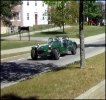I agree that this is not the place but I do not agree with your arguments made in those posts. If you have the time:
http://nofilmschool.com/2015/09/how-shutter-speeds-frame-rates-change-look-feel-of-film
So apparently, although you agree this isn't the place to have this discussion, you do it anyway. OK, that video has been rolled out here on DCT too, long ago. If you actually pay attention to what they are saying it is not relevant to this discussion. The narrator is talking about
artistic intent in filming making. He goes on to talk about making shutter speed and frame rate decisions in film making designed to
"Really impact our audience" and what he describes as,
"It just feels right". He further speaks of setting your frame rates and shutter speeds
"In a way that is FITTING to the story you are telling" This has nothing to do with what we seek in dash cam footage, how dash cams function and it ignores issues such as refresh rates in playback as well. We are seeking absolute documentation, not emotional, artistic story telling.
Personally, I will go with the facts as spelled out in the post I referred to and the documentation links rather than filmmakers giving biased tutorial about how to "adjust" the frame rate/shutter speed ratios in order to achieve a particular artistic effect in the service of storytelling. Those arguments and opinions were not mine btw but those of the director Peter Jackson, the special effects master Douglass Trumball and the manufacturer of the RED Digital Cinema cameras.
Actually, the various filmmakers are basically saying the same thing but they differ on the value and uses of employing higher frame rates in cinema.

